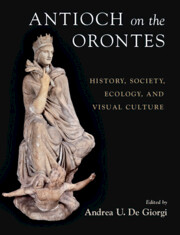Book contents
- Antioch on the Orontes
- Antioch on the Orontes
- Copyright page
- Dedication
- Contents
- Plates
- Figures
- Tables
- Contributors
- Abbreviations
- Antioch on the Orontes
- Part I Beginnings
- Part II The Making of a Capital
- Part III The People of Antioch
- Part IV Religion
- Part V Crises and Resilience
- Index
- Plate Section
- References
Part III - The People of Antioch
Published online by Cambridge University Press: 06 June 2024
- Antioch on the Orontes
- Antioch on the Orontes
- Copyright page
- Dedication
- Contents
- Plates
- Figures
- Tables
- Contributors
- Abbreviations
- Antioch on the Orontes
- Part I Beginnings
- Part II The Making of a Capital
- Part III The People of Antioch
- Part IV Religion
- Part V Crises and Resilience
- Index
- Plate Section
- References
Summary

- Type
- Chapter
- Information
- Antioch on the OrontesHistory, Society, Ecology, and Visual Culture, pp. 245 - 356Publisher: Cambridge University PressPrint publication year: 2024

